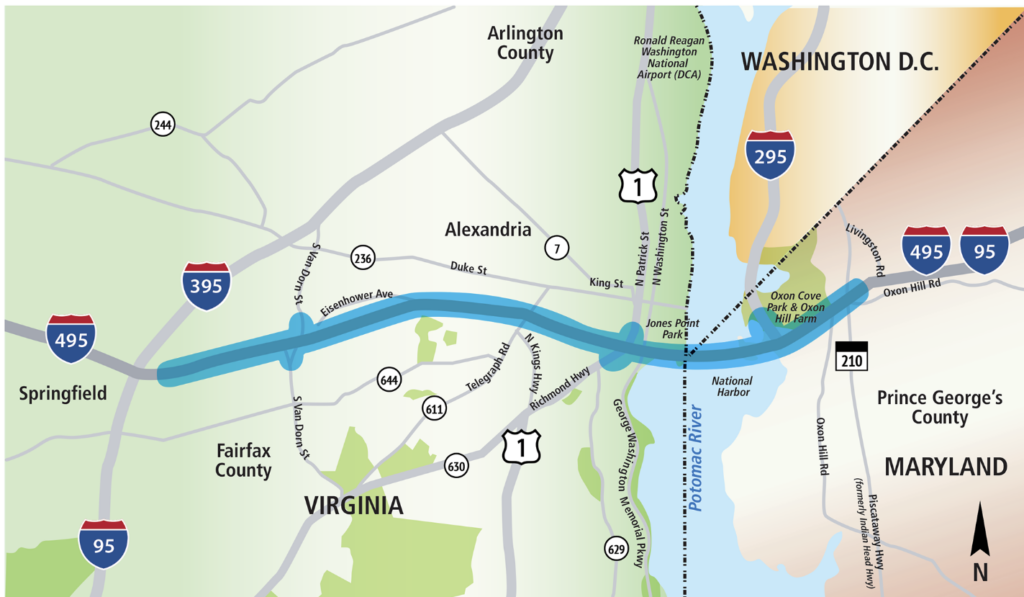VDOT’s HOT lanes would mean more traffic in Fairfax, Alexandria, & Prince George’s; threatens Metro

The Virginia Department of Transportation (VDOT) wants to widen I-495 from Springfield to Oxon Hill and add private High Occupancy Toll (HOT) lanes. It would take the right of way reserved for Metrorail, add traffic to connecting roads, and create a new bottleneck.
The many problems with VDOT’s proposed widening for HOT lanes – and better alternatives:
- VDOT’s HOT lanes proposal would create a major new traffic bottleneck in Prince George’s County, MD where the widened highway would end.
- The expanded I-495 would generate more traffic, meaning more cars would clog connecting roads like MD 210, Route 1, Telegraph Rd, and Van Dorn St as they access I-495.
- Private toll road operators count on continued heavy congestion in the “general purpose” lanes to generate high tolls for their profits (see this independent technical analysis). So, most commuters would continue to sit in traffic when incidents occur and during busy peak periods.
- Metrorail on Wilson Bridge is at risk with HOT lanes proposed to use the space reserved for rail, with significant costs to retrofit the lanes, remove HOT lanes infrastructure, and modify legal agreements with a private toll concessionaire to extend Metro in the future.
- Widening 495 south of Alexandria to add 4 lanes would require significant clearing of trees and impacts to streams and wetlands.
- VDOT’s “conclusions first” study is biased beginning with a project purpose to “extend and provide continuity of the Express Lanes system,” which effectively excludes other alternatives. Other solutions are available!
- VDOT refused to study other transit (including dedicated bus lanes and Metro), HOV and travel demand management solutions in addition to HOT lanes in the detailed environmental assessment, even when officials with the City of Alexandria, WMATA, Prince George’s County, and local members of the VA General Assembly asked.
- Transit-oriented development and travel demand management are more effective solutions than HOT lanes, according to the National Capital Region Transportation Planning Board (TPB). These also offer shorter commutes, walkable communities, healthy and more affordable travel options, and less vehicle pollution.
- The underlying cause of peak backups on the Beltway is the east-west jobs and housing imbalance. The most effective long-term solution – combined with dedicated lanes for transit and carpooling – is more jobs and housing at transit stations in Prince George’s, at future Bus Rapid Transit stations in Fairfax along Richmond Highway, and at Alexandria’s Metro and bus stations.
- The region should not make multi-billion dollar decisions on projects with significant community and environmental impact without fairly and objectively modeling traffic and evaluating alternatives.
More information:
VDOT project website
In-Person Testimony: 495 Southside Study by the Coalition for Smarter Growth
Not ready for prime time. The flawed 495 Southside Express Lanes, summary article by Bill Pugh, Coalition for Smarter Growth, in Greater Greater Washington, June 13, 2024
Induced Demand: An Overview for Metro DC by the Coalition for Smarter Growth
Independent technical analysis of similar proposed HOT lanes, “Review of Maryland I-495 & I-270 Managed Lanes Final Environmental Impact Statement and Final Section 4(f) Evaluation,” by Norm Marshall, Smart Mobility, Inc.
Image source: VDOT I-495 Southside Express Lanes Study
